The cockatoo cichlid (lat. Apistogramma cacatuoides) is one of the easiest dwarf cichlids to keep, however it’s not the most spread one among the aquarists. It’s difficult to tell why it happened so, – possibly it’s the order of the day now or it’s about the fact that this fish is higher priced. But it is likely to be about the fry color which is inconspicuous and which doesn’t hit the eye considering all the motley of the market.
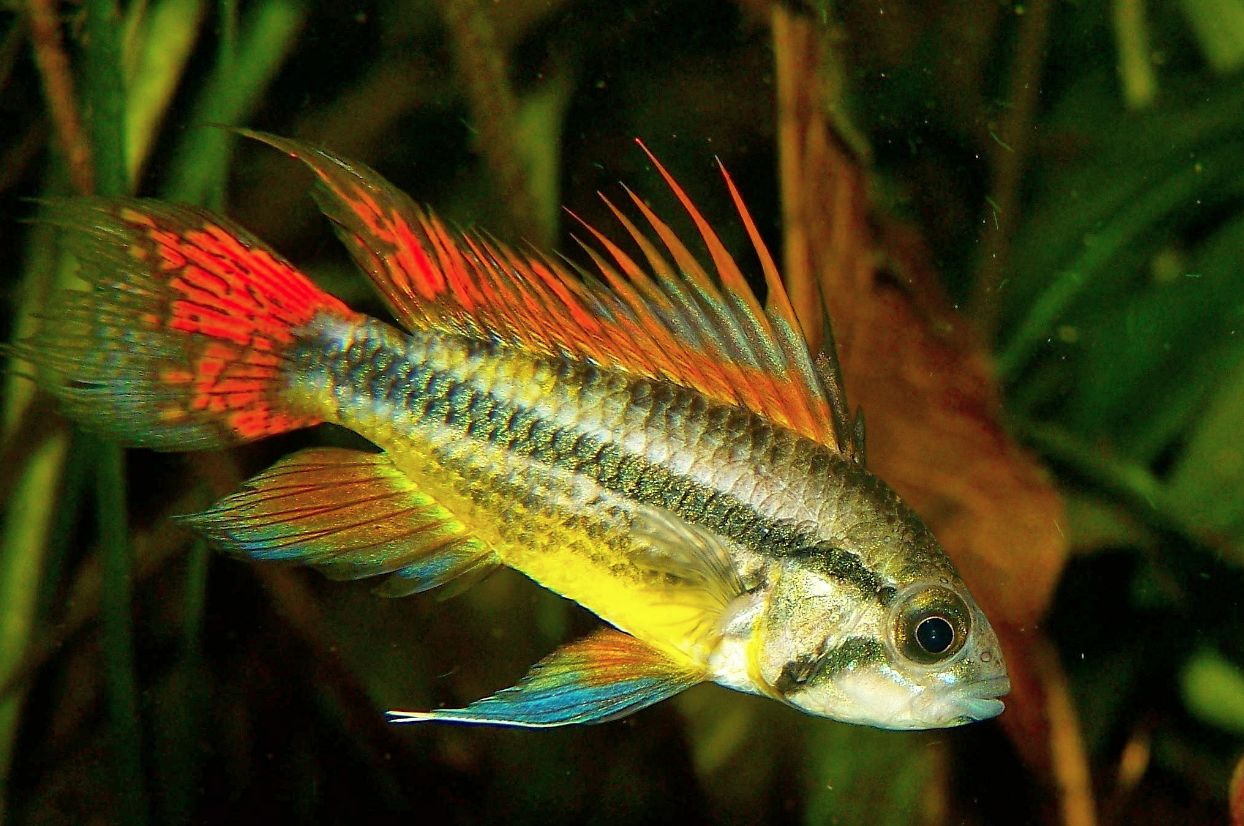
Contents
Habitat in the wild
Apistogramma cacatuoides was first mentioned and described in 1951. Cockatoo cichlid are found in various countries throughout South America, including Brazil, Colombia, Peru, and Bolivia. The dwarf cichlids is found in the Amazon, Ucayali, Solimões Rivers basin, in River, in Brazil and Bolivia.
The cockatoo cichlid prefers small shallow streams or lagoon-like waters mainly in Amazon River tributaries. These can be different backwaters, springs and the bottom of these waters is covered with thick layer of leaves. They are known to thrive in blackwater environments with tannin-stained water.
Depending on the season the water parameters may differ sufficiently, since the fallen leaves when rotting make the it more acidic and soft. Their natural habitat often consists of densely vegetated areas with submerged plants, floating vegetation, and overhanging branches. These provide shelter, hiding spots, and breeding territories for the fish. The substrate in their habitat is usually composed of fine sand, leaf litter, and decomposing organic matter.
Apistogramma cacatuoides are polygamous fish and live in harems which consist of alpha male and several females.
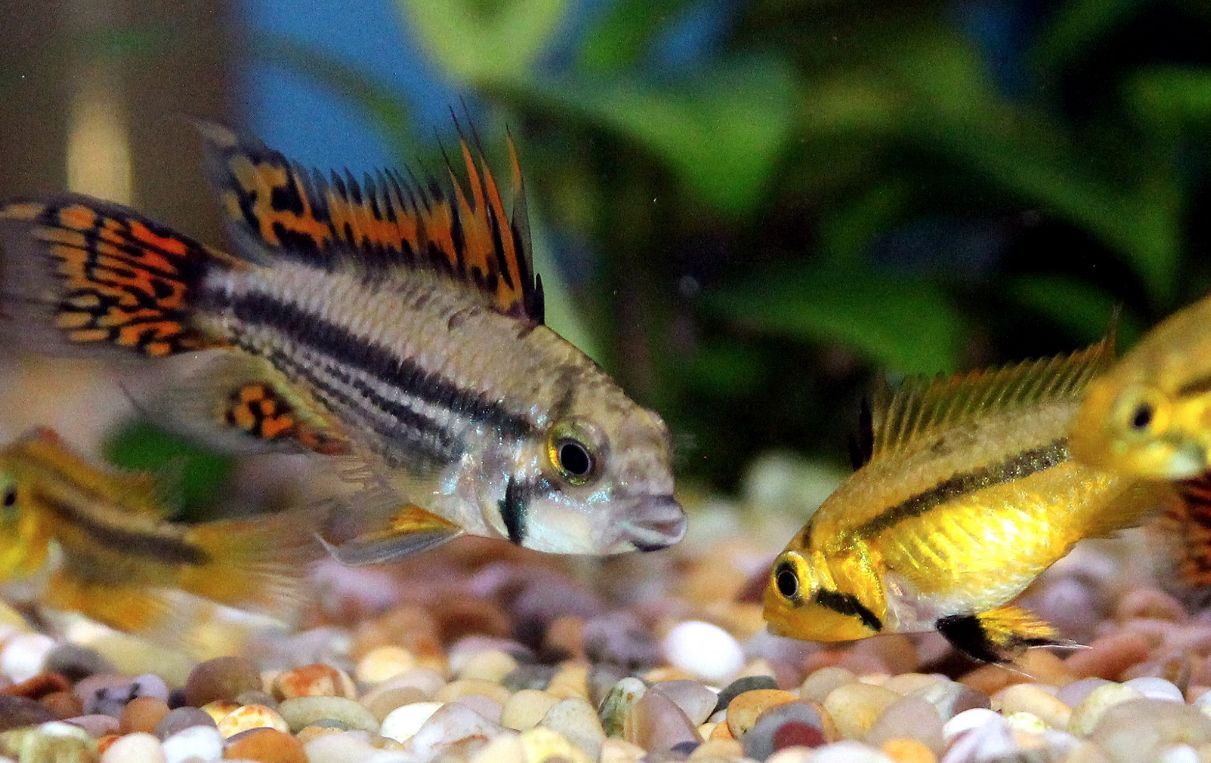
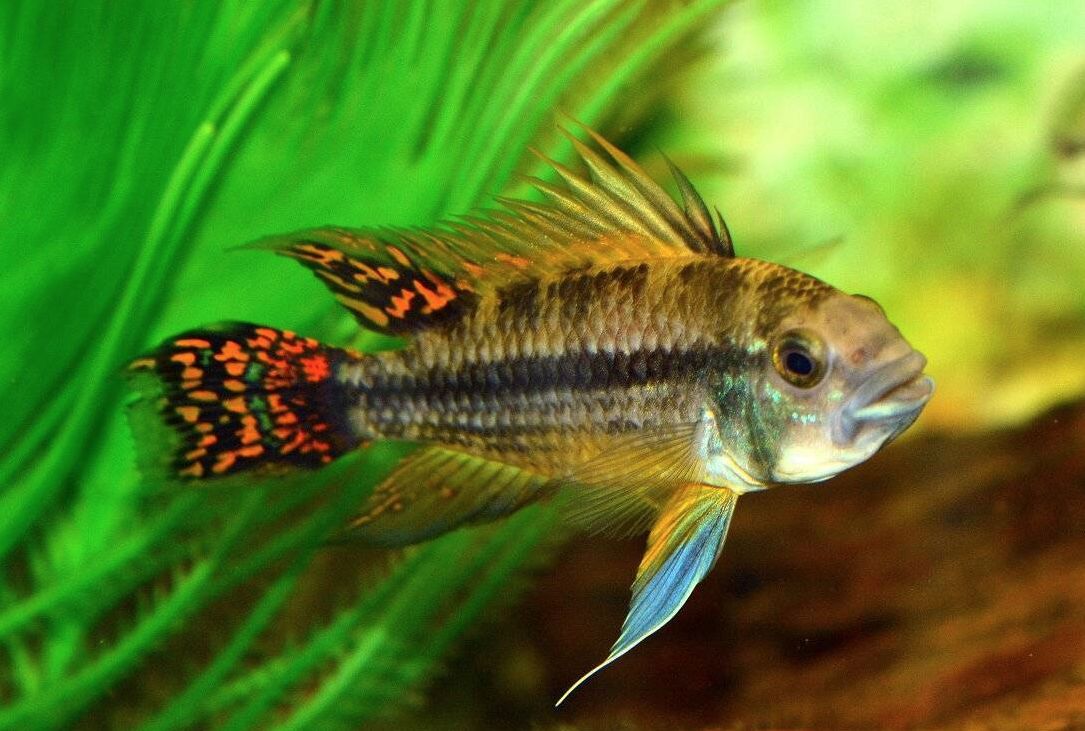
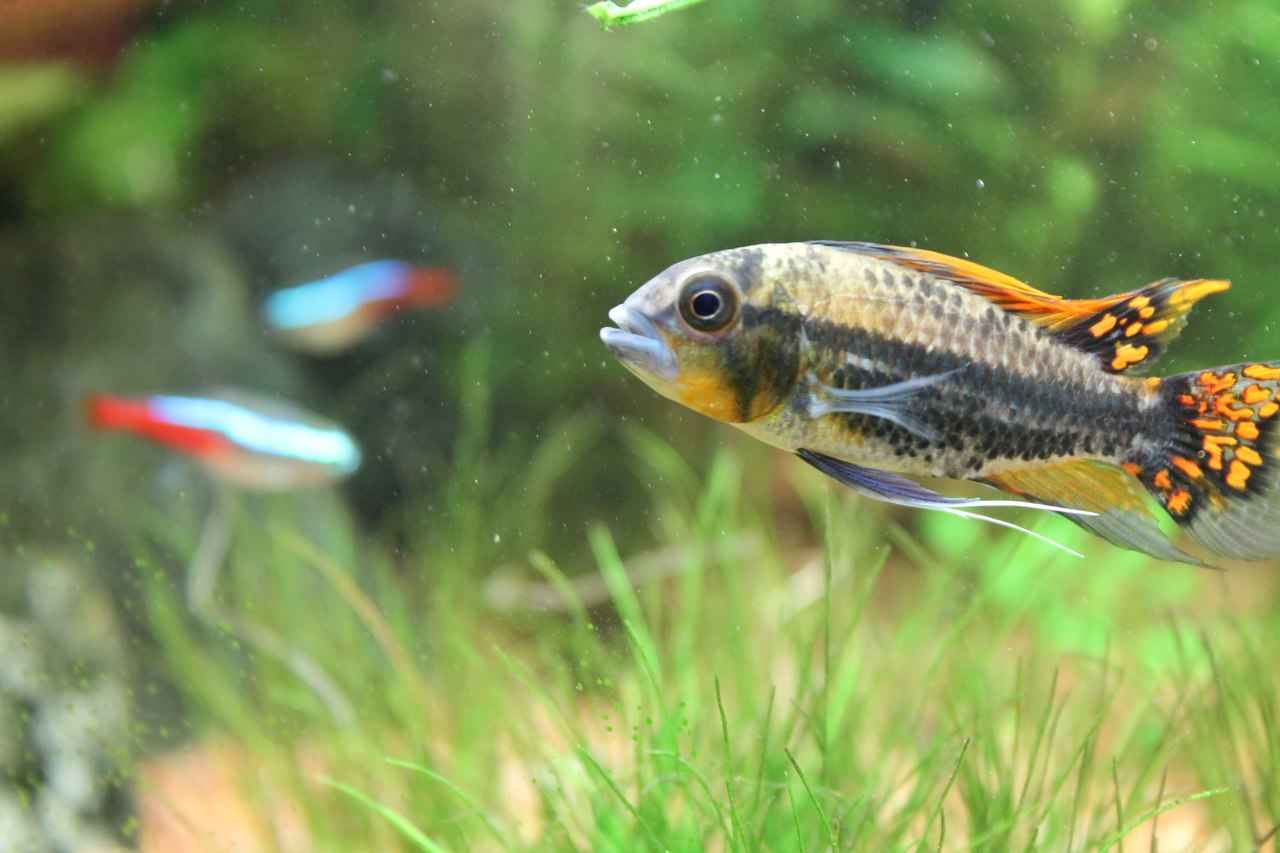
Description
Color
A small bright fish with the body typical for dwarf cichlids. Cockatoo Cichlids are known for their vibrant colors and unique patterns. Males typically have longer fins with bright red, orange, or yellow coloration, while females exhibit more subdued colors. The male’s several first lines on the dorsal are longer then the others and they resemble a cockatoo’s crest that’s how cichlid got its name.
Size
How big do apistogramma cacatuoides get?
The cockatoo cichlid male is larger in size (up to 10 cm or 4 in) and the female is significantly smaller (reaching only 5 cm or 2 in). It’s important to note that individual fish may vary slightly in size based on genetics, diet, and overall health.
Lifespan
How long do apistogramma cacatuoides live?
Cockatoo Cichlids, generally have a lifespan of around 3-5 years in captivity. However, with proper care and optimal conditions, they can potentially live longer.
Types
The Apistogramma cacatuoides is a species with several recognized color variations or morphs. Here are some notable types or variations of Cockatoo Cichlids:
- Wild-Type Cockatoo Cichlid: This refers to the natural coloration of Cockatoo Cichlids found in their native habitats. Wild-type specimens have more subdued colors, with males displaying hints of red, orange, and blue.
- Triple Red Cockatoo Cichlid: This variety displays vibrant red coloration, particularly in the fins and body. The red coloration is more intense in males, while females exhibit a paler red or orange color.
- Orange Flash Cockatoo Cichlid: This morph features bright orange coloration in both males and females. The intensity of the orange hue can vary, but it generally stands out.
- Super Red Cockatoo Cichlid: This variation exhibits intense and deep red coloration, more so than the standard Triple Red variety. It is highly sought after by hobbyists for its striking appearance.
- Gold Cockatoo Cichlid: As the name suggests, this morph displays a beautiful golden coloration. Males typically have a more vivid golden hue, while females tend to be paler.
It’s important to note that the availability of these variations may vary depending on your location and the availability of breeders or suppliers. Additionally, breeders continue to work on developing new color variations, so there may be other types or hybrids available in the future.
| Characteristic | Description |
|---|---|
| Scientific Name | Apistogramma cacatuoides |
| Common Name | Cockatoo Cichlid, cockatoo dwarf cichlid |
| Adult Size | 3-4 inches (7-10 cm) |
| Lifespan | 3-5 years (can vary with proper care) |
| Native Region | South America, Amazon River basin |
| Water Temperature | 75-82°F (24-28°C) |
| Water pH | 6.0-7.5 |
| Water Hardness | Soft to moderately hard water |
| Behavior | Generally peaceful, males may become territorial |
| Coloring | Males: Vibrant colors (red, orange, yellow), Females: Subdued colors |
| Diet | Omnivorous – prefers live/frozen foods, high-quality pellets/flakes |
| Breeding Behavior | Complex parental care, males build and guard territories, females deposit eggs in prepared pits |
| Tank Size | Minimum 20-gallon tank for a pair or small group |
| Tank Setup | Heavily planted with hiding spots (caves, driftwood), soft substrate (sand), and gentle water flow |
| Compatibility | Peaceful community fish (avoid aggressive or larger species) |
| Special Considerations | Provide suitable hiding spots and territories, regular water changes, and proper filtration |
Difficulties in keeping
On the assumption that the aquarium has stable conditions they are good even for beginners. This fish adapts well and it eats different feed. Besides they are rather peaceful and not aggressive.
Just like all dwarf cichlids the cockatoo cichlid is good for community tank. The fish is small in size and it’s not an aggressive one so it even can be kept together with small tetras (Characinidae). Then again it’s a cichlid after all and still it will hunt fry and small prawns, therefore it’s better not to keep them together.
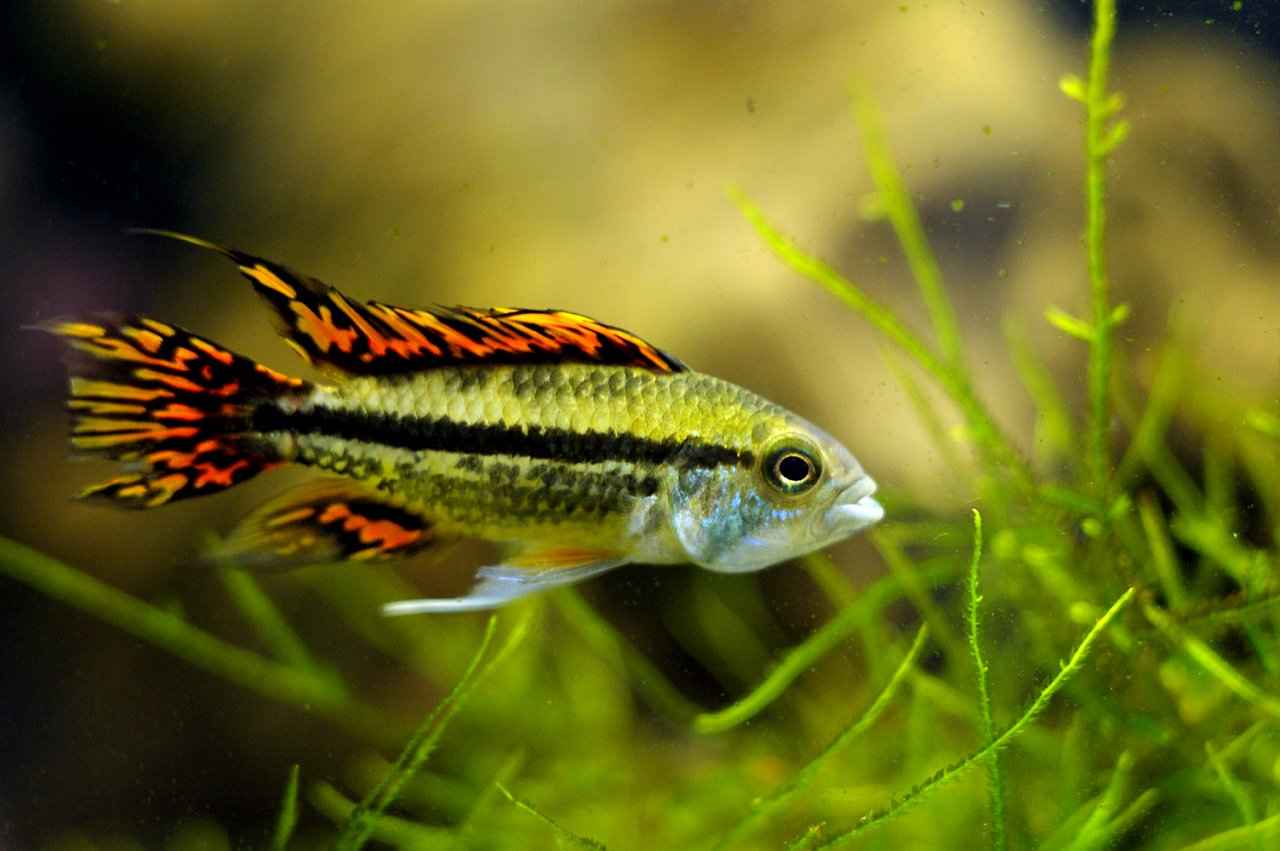
Care and keeping in a tank
Tank size
For a pair or a small group of cockatoo cichlids, it is recommended to provide a tank with a minimum size of 20 gallons (75 liters). However, larger tanks are always beneficial as they offer more swimming space and allow for better territorial establishment. A 20-gallon tank can accommodate a pair of cockatoo cichlids comfortably, allowing them to establish territories and exhibit their natural behaviors. Adding more individuals would require a larger tank to accommodate their social dynamics and minimize aggression.
It’s important to consider the dimensions of the tank as well. Providing a tank with a length of at least 24 inches (60 cm) allows for better swimming space and territorial separation.
Water parameters
Optimal maintenance parameters are:
- Temperature: The ideal temperature range for Cockatoo Cichlids is between 75-82°F (24-28°C). Maintaining a stable temperature within this range is important for their overall health and well-being.
- pH Level: The recommended pH range is between 6.0 and 7.5. It’s important to avoid significant fluctuations in pH, as stability is key for their health.
- Water Hardness: Cockatoo Cichlids thrive in relatively soft to moderately hard water. The recommended water hardness range is around 5-12 dKH (90-215 ppm).
- Ammonia, Nitrite, and Nitrate: It’s important to control water parameters and purity, since fish is very sensitive to the presence of ammonia and nitrates in the water. It’s crucial to keep ammonia and nitrite levels at zero, as these substances are toxic to fish. Regular water testing and proper filtration are essential to maintain a healthy nitrogen cycle in the aquarium. Nitrate levels should be kept below 20-30 ppm through regular water changes.
- Filtration and Aeration: Fish prefer water with high content of dissolved oxygen and moderate flow. To create such conditions it’s necessary to use a filter rather an external one since the fish is sensitive to the level of ammonia in the water. Not to mention a regular water change and aquarium bottom siphonage which are obligatory
.
Decor
As for the décor it should be mentioned that dwarf cichlid look better on a dark background. Use a soft substrate such as fine sand or small-grain gravel. This allows the cichlids to dig and sift through the substrate, which is a natural behavior for them.
Cockatoo cichlid prefers an aquarium tightly covered with plants, with scattered and not bright light. Provide moderate lighting levels. Avoid extremely bright lights, as Cockatoo Cichlids are more comfortable in dimmer lighting conditions that mimic their natural habitat.
Lots of caves are necessary. Fish will protect them from the other aquarium inhabitants. Provide plenty of driftwood and rocks to create hiding places, caves, and territories for the cichlids. These materials also help create natural boundaries and break the line of sight, reducing aggression and stress. Ensure that the rocks are stable and won’t topple over. Divide the aquarium into sections so that each would have its own shelter and belong to one female.
It’s a must to add different kind of shelters into the aquarium – one for each cichlid female, plus they should be in different spots of aquarium for each female to have its own territory. They like aquarium with high number of plants, soft light and small amount of dry leaves in it.
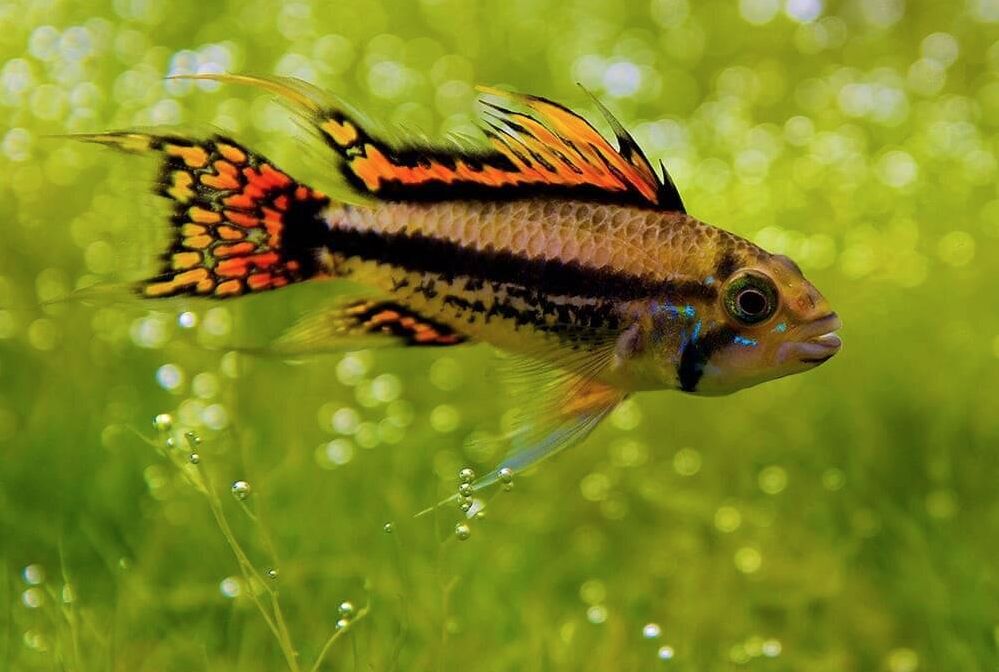
Diet
Cockatoo cichlid is omnivorous and in the wild it feeds with different insects that in a plenty live on the waters bottom in the fallen leaves.
In the tank the fish eats all types of live, frozen and artificial feed. It’s important to note that the diet of Cockatoo Cichlids should be varied and balanced. Offering a combination of dry, frozen, live, and vegetable-based foods will help ensure they receive all the necessary nutrients for optimal health and coloration.
A staple part of their diet can be high-quality pellets or flakes specifically formulated for cichlids. Look for products that provide balanced nutrition and are suitable for small-sized cichlids.
Cockatoo Cichlids greatly benefit from the inclusion of live and frozen foods in their diet. Offer them a variety of options such as brine shrimp, bloodworms, daphnia, and small insect larvae. These foods provide essential nutrients and help replicate their natural diet.
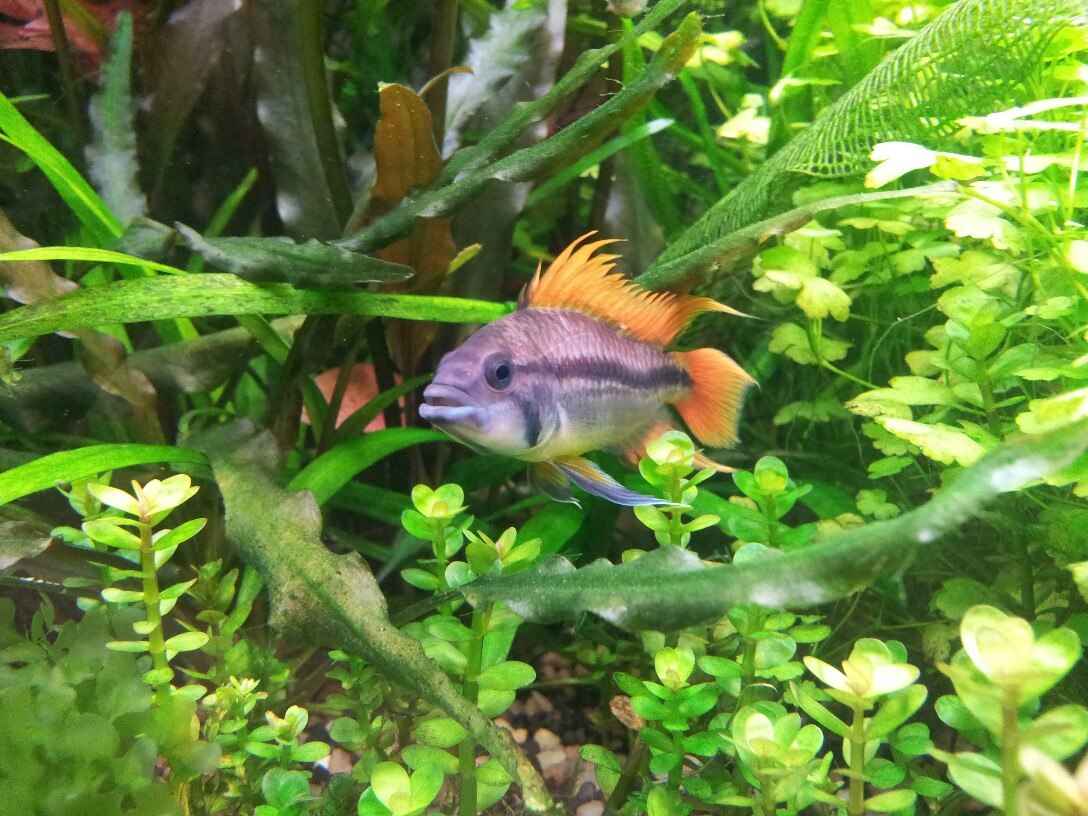
Tank mates
Cockatoo cichlids are good to keep in a community tank and can be kept with a variety of peaceful fish species that share similar water requirements and temperaments. Not aggressive fish of equal size can be good tank mates. They can be kept both in pairs and in harems that consist of one male and 2-3 females. If you are interested in breeding or maintaining a small group of these fish, it is advisable to keep a male-female ratio of 1:2 or 1:3 to minimize aggression and provide a more natural social structure. Note that it’s possible to have more then one male only in case when tank is rather spacious.
Here are some suitable tank mates for Cockatoo Cichlids:
- Harlequin Rasboras (Trigonostigma heteromorpha)
- Neon Tetras (Paracheirodon innesi)
- Ember Tetras (Hyphessobrycon amandae)
- Glowlight Tetras (Hemigrammus erythrozonus)
- Black Neon Tetras (Hyphessobrycon herbertaxelrodi)
- Cardinal Tetras (Paracheirodon axelrodi)
- Rummy Nose Tetras (Hemigrammus rhodostomus)
- Dwarf Gouramis (Trichogaster lalius or Trichogaster chuna)
- Sparkling Gouramis (Trichopsis pumila)
- Celestial Pearl Danios (Danio margaritatus)
- White Cloud Mountain Minnows (Tanichthys albonubes)
- Dwarf Rasboras (Boraras spp.)
- Endler’s Livebearers (Poecilia wingei)
- Guppies (Poecilia reticulata)
- Platies (Xiphophorus spp.)
- Corydoras Catfish (Corydoras spp. – pygmy cory, panda cory, adolfoi catfish)
- Otocinclus Catfish (Otocinclus spp.)
- Bristlenose Plecos (Ancistrus spp.)
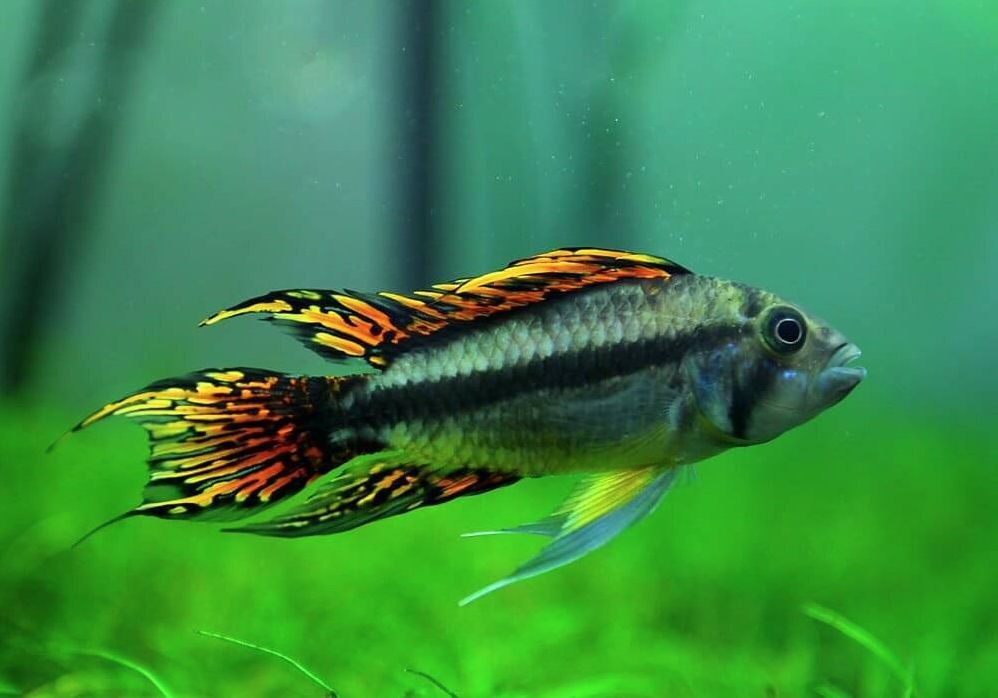
Gender differences: male vs female
Both male and female Cockatoo Cichlids (Apistogramma cacatuoides) have their unique characteristics and appeal. Here are some distinguishing features between the sexes:
Males:
- Size: Males tend to grow slightly larger than females, reaching lengths of around 3-4 inches (7-10 cm).
- Coloration: Adult males exhibit vibrant and striking colors, including intense red, orange, yellow, and blue hues. They often have more intricate and elaborate patterns on their fins and bodies.
- Fins: Males typically have more elongated and pointed dorsal and anal fins, which they use to display and court females.
- Body Shape: Males may have a more streamlined and elongated body shape compared to females.
- Behavior: Males are generally more territorial and exhibit more aggressive behavior, especially during breeding and spawning. They are known to build and guard territories.
Females:
- Size: Females are slightly smaller in size compared to males, typically reaching lengths of 2.5-3 inches (6-8 cm).
- Coloration: Adult females have more subdued and less vibrant colors compared to males. Their colors tend to be paler, with shades of orange or yellow.
- Fins: Females generally have shorter and rounder dorsal and anal fins compared to males.
- Body Shape: Females may have a more rounded and robust body shape, especially when they are carrying eggs.
- Behavior: Females are typically less aggressive and more social than males. They play a vital role in selecting and preparing breeding sites.
Breeding
Cockatoo cichlid are polygamous fish and live in harems which consist of alpha male and several females. Such a harem protects its area from everyone except alpha male.
They generally spawn up to 80 eggs. Since cichlids breed in caves they stick their eggs to the ceiling of a cave. After that the female takes care of the eggs whilst the male guards the territory.
So it’s important to put several types of covers — flowerpots, coconuts, bogwood are quite good for this purpose. The water in spawning pond does need to have a pH under 7.5 for the eggs to hatch.
Ideal conditions are pH of 6.8 to 7.2 or less, hardness of 10 or less and temperature of 78° to 84° F (26 to 29 °C). As a rule the more acidic and soft is the water, the more prolific they are.
To find a good cockatoo cichlid match we offer to buy 6 juveniles so they’ll grow together. During interbreeding process many species become sterile or have some spinal problems, so you’ll get one pair out of 6 fish or a harem if you are lucky.
While spawning the male will approach the female, curve his body, and display hos best colors to catch her attention.
Then the female lays up to 80 reddish eggs on the walls of her cave. The male fertilizes them. After that he leaves this cave to keep an eye on the outside area.
The female is left to care for the eggs. If there is a harem, the male will come to the “cave” of another female and fertilize her eggs.
It’s funny, that if there are several females they will tend to steal each others fry and add it to their school!
Depending on the water temperature it takes from 3 to 4 days for the eggs to hatch. Several days later the fry will be swimming. It was noticed, that if the water temperature is lower then 21°C most of the fry will be females, if it’s higher then 29° C, the majority will be males.
To a much less extent pH also plays a role in the gender of the fry. For successful fry growth it’s necessary for the tank parameters to be stable during the first three weeks.
The juveniles grow quickly and in a few weeks time they can be fed with nauplii, although powder, Vinegar eels and egg yolk are used as start feeding.